Tabgha and Mensa Christi, the place of Multiplication Miracle of Bread and Fish is two of most important place to the christians pilgrims when they visit the Holy Land.
Tabgha and Mensa Christi are located side by site in the northern shore of Ginosar Lake, the Sea of Galilee. This place was consider by the ancient tradition as the site of many important event described in the gospels.
Heptapegon; also Tabgha. A system of springs (the name Heptapegon means ‘seven fountains’) just southwest of Capernaum. According to Christian tradition, it was in this area that Jesus preached the Sermon on the Mount (Matthew 5:1-11; Luke 6:16-49), fed the five thousand (Matthew 14:13-21; Mark 6:32-44; Luke 9:10-17; John 6:1-13), and appeared to his disciples after his resurrection (John 21:1-24).
Índice
The Multiplication Event Described in the Matthew
“When Jesus heard of it, he departed thence by ship into a desert place apart: and when the people had heard thereof, they followed him on foot out of the cities. And Jesus went forth, and saw a great multitude, and was moved with compassion toward them, and he healed their sick. And when it was evening, his disciples came to him, saying, This is a desert place, and the time is now past; send the multitude away, that they may go into the villages, and buy themselves victuals. But Jesus said unto them, They need not depart; give ye them to eat.And they say unto him, We have here but five loaves, and two fishes. He said, Bring them hither to me.And he commanded the multitude to sit down on the grass, and took the five loaves, and the two fishes, and looking up to heaven, he blessed, and brake, and gave the loaves to his disciples, and the disciples to the multitude. And they did all eat, and were filled: and they took up of the fragments that remained twelve baskets full. And they that had eaten were about five thousand men, beside women and children.”
(Matthew 14:13–21 KJV)
The Christian’s Tradition
Not far away (from Capharnaum) the stone steps on which the Lord stood can be seen. There, near the sea, the land is covered with grass and hay is plentiful. There are a lot of palm trees ad nearby are seven springs which provide abundant water: in this lush land, the Lord fed a multitude with five loaves of bread and two fish. The stone on which the Lord laid the bread has become an altar. The public thoroughfare, where Matthew had his tax collection post, passes near the walls of that church. The neighbouring mount is where the Lord went to say the Beatitudes”. This text, kept in a small medieval book on the Holy Places and attributed to the pilgrim Egeria (381-384 AD), is the best evidence of the Christian memories of Tabgha, the name of which is a deformation of the Greek Heptàpegon (seven springs).
The church of the multiplication of the loaves (brought back to the light in 1932 by the Benedictine E. Mader) is in the plain, amidst the springs, with its ancient mosaics of the Nilotic type and the famous rock under the altar in front of which a mosaic represents the bread and fish used by Jesus to feed the multitude. The Sanctuary of the Beatitudes stands on the nearby mount: the older one, lower down, near the road (excavated in 1936 by Father B. Bagatti) and the new one (designed by the architect A. Barluzzi in 1938) on a higher hillock.
Dalmanutha/Magadan. Except at Mark 8:10 Dalmanutha (Gk Dalmanoutha) is not attested as a site where Jesus went ashore. The parallel (Mt 15:39) speaks of “the region of Magadan.” The rest of the narrative (Mt 16:1-4; Mk 8:11-13) seems to indicate a place on the west shore of the Sea of Galilee. It has been proposed that Mark understood “Dalmanutha,” which in Aramaic could mean “area of his [Jesus’] stay,” as a specific place name (GBL I.247-48). Some derive Magadan (Gk Magadan) from may–gad, “water of (the Canaanite god of springs) Gad”; this would fit in well with the abundant springs of Tabgha two kilometers southwest of Capernaum. Josephus calls them the “spring of Capernaum” (J.W. 3.10.8 §517), and Byzantine sources speak of the seven springs (Gk Heptapēgon, from which the garbled Arabic Eṭ-Ṭâbghah is derived). This appears to have been, in fact, one of Jesus’ preferred locations for ministry, one at which he was able to reach large crowds (GBL 2.767). The important trade route from Caesarea Maritima to Damascus bordered the Sea of Galilee at this point, and there was sufficient drinking water available. As early as the end of the fourth century, the Christian pilgrim Egeria found here three firmly grounded local traditions (ELS 281–82): the Sermon on the Mount (see SERMON ON THE MOUNT), the feeding of the five thousand, and the post-resurrection appearance of Jesus related in John 21. These traditions deserve to be taken seriously because there was a continuous Jewish-Christian presence in Capernaum from NT times until the fourth century, providing a means by which the traditions could be passed along.
Events in Tabgha Area
First and Second Miraculous Feeding
The Jewish Christians thought of the first feeding (Mt 14:13-21 par.) as taking place at an exposed rock at the edge of a small, fertile plain in Tabgha. The pilgrim Egeria found that the rock had been incorporated into a church building, serving as the altar, as it is today. Since the area was uninhabited in NT times, one could speak of a “lonely place” (Mt 14:13; Mk 6:32). Now it appears, nevertheless, that John presupposes that the feeding of the five thousand took place on the eastern shore (cf. Jn 6:1, 17, 22-24). The original text has multiple variants at this point, however, and John can just as easily be understood to assume a location on the western shore (R. E. Brown, The Gospel of John, 1971, I.231-59). Luke 9:10 also can be understood to say that the feeding took place not in but on the way to Bethsaida. Perhaps behind Luke 9:12 (episitismos, “food,” “something to eat”) stands a Hebrew wordplay (b́ṭ ṣēḏă, “house of food”). The view that the feeding of the four thousand is not simply a doublet may be upheld by topographical considerations: Matthew 15:31 presupposes the presence of Gentiles, and Mark 7:31 appears to have the Decapolis in mind. Late Byzantine traditions (ELS 278–79) actually transfer the second feeding to the area of Kursi (see 4.1. below) on the eastern shore (GBL I.442).
Jesus’ Appearance by the Sea
Egeria located the encounter between the resurrected Jesus and his disciples (Jn 21) in Tabgha at some rock stairsteps still visible today (cf. Jn 21:9). A small church had been erected in the immediate vicinity already in the fourth century. The beach of Tabgha was an especially good fishing area, since the water of the warm springs and the vegetation they carry attract many fish, especially at night (cf. Jn 21:3). Another indication of fishermen’s fondness for this site is a small, ancient boat harbor (GBL II.767).
“ARCHEOLOGY AND GEOGRAPHY,” DJG, 39.
Suggested Pray for Christians
Guide. To God who, in his Providence, built the Church on the Rock of Peter and the Apostles, we address our pleas. All. Listen to us, O Lord.
1. For the Pope, Peter’s successor, so that he may precede all in the unfailing love for Christ, the Good Shepherd who gave His life for the flock. Let us pray:
2. For all the believers in Christ, so that the shepherds and faithful make every effort to repair the net of the Church which is torn by divisions and discord. Let us pray:
3. For the rulers of peoples and the heads of nations, so that they see in the Church of Christ the sign and the instrument of the unity of all mankind. Let us pray:
4. For the Catholic faithful, so that they may feel the grace and the responsibility of being part of the Church guided by the Pope and by the Bishops in the bond of unity, of charity and peace. Let us pray:
5. For all those who are suffering and undergoing ordeals, so that nothing and nobody may ever separate them from the salvific love of Christ. Let us pray:
6. For ourselves, pilgrims, so that the memory of the continuation of Peter and of the other Apostles , of Mary of Magdalene and the first women followers renew in us the grace of the discipleship. Let us pray:
Guide. O God, supreme shepherd of the believers, look at Your Son’s flock with love and bring together in the integrity of the faith and in the bond of charity those who have been consecrated by a single baptism. For Christ Our Lord. All. Amen
Tabgha’s church
P.O.B. 1931 – Tabgha
14101 Tiberias
ISRAEL
Tel.: 04-672.47.67
Fax: 04-671.69.62
Opening hours of the sanctuary
8.00-16.50




